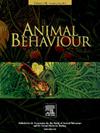Animal-borne video highlights diverse prey capture tactics and habitat use in the Australian sea lion
IF 2.3
2区 生物学
Q2 BEHAVIORAL SCIENCES
引用次数: 0
Abstract
Understanding the foraging ecology of predators is critical to identifying the resources and habitats that maintain their populations and is essential for their conservation and management. For marine predators that spend extended periods at sea and underwater, the use of animal-borne video provides a novel method of observing individuals in their environment and the foraging behaviours they employ. The endemic Australian sea lion, Neophoca cinerea, is listed as endangered, with its populations declining by more than 60% over the last 40 years. Due to the highly subdivided genetic structure of Australian sea lion populations, an intimate understanding of their foraging behaviour, throughout their distribution, is needed to support targeted management at the breeding site level. Here, we use animal-borne video collected from 10 adult female Australian sea lions from five colonies in South Australia to identify the prey capture tactics they use across different benthic habitats. We identified a variety of prey capture tactics (probing, chasing, pelagic ambushing of schooling fish, flipping rocks/substrate and sit-and-wait predation), exploiting a range of benthic habitats, including seagrass meadows, bare sand plains and macroalgae reefs, while hunting diverse prey, such as benthic/epibenthic fishes, cephalopods and elasmobranchs. The prey capture tactics most frequently observed were probing and chasing, which were used by all individuals, whereas flipping rocks, sit-and-wait predation and pelagic ambush were less frequent. Using specialist prey capture tactics, such as sit-and-wait predation, may increase the capacity of sea lions to exploit a greater diversity of prey and benthic habitats, which could increase their overall success and fitness. This study underscores the significance of animal-borne video as a crucial tool for identifying and mapping the critical habitats and resources essential for Australian sea lions.
动物传播的视频突出了澳大利亚海狮不同的猎物捕获策略和栖息地的使用
了解捕食者的觅食生态对于确定维持其种群的资源和栖息地至关重要,对它们的保护和管理至关重要。对于长时间在海上和水下生活的海洋捕食者来说,使用动物传播的视频提供了一种观察环境中的个体及其觅食行为的新方法。澳大利亚特有的海狮Neophoca cinerea被列为濒危物种,在过去的40年里,它的种群数量下降了60%以上。由于澳大利亚海狮种群的遗传结构高度细分,因此需要深入了解它们在整个分布中的觅食行为,以支持在繁殖地水平上进行有针对性的管理。在这里,我们使用从南澳大利亚五个殖民地的10只成年雌性澳大利亚海狮收集的动物传播视频来确定它们在不同底栖动物栖息地使用的猎物捕获策略。我们确定了各种猎物捕获策略(探测,追逐,远洋伏击鱼群,翻转岩石/基质和静坐等待捕食),利用一系列底栖动物栖息地,包括海草草甸,裸露的沙滩平原和大型藻类珊瑚礁,同时捕猎各种猎物,如底栖/底栖鱼类,头足类和板鳃类。最常见的捕获策略是探测和追逐,所有个体都使用这种策略,而扔石头、坐等捕食和远洋伏击的频率较低。使用专门的猎物捕获策略,比如坐等捕食,可能会增加海狮利用更多样化的猎物和底栖生物栖息地的能力,这可能会提高它们的整体成功率和适应性。这项研究强调了动物传播视频作为识别和绘制澳大利亚海狮重要栖息地和资源的重要工具的重要性。
本文章由计算机程序翻译,如有差异,请以英文原文为准。
求助全文
约1分钟内获得全文
求助全文
来源期刊

Animal Behaviour
生物-动物学
CiteScore
4.60
自引率
8.00%
发文量
236
审稿时长
10.2 weeks
期刊介绍:
Growing interest in behavioural biology and the international reputation of Animal Behaviour prompted an expansion to monthly publication in 1989. Animal Behaviour continues to be the journal of choice for biologists, ethologists, psychologists, physiologists, and veterinarians with an interest in the subject.
 求助内容:
求助内容: 应助结果提醒方式:
应助结果提醒方式:


